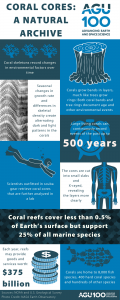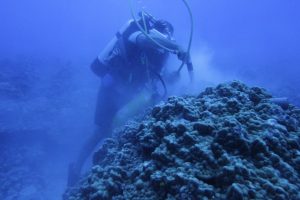4 September 2018
Polluted groundwater likely contaminated South Pacific Ocean coral reefs for decades
Posted by kcawdrey
By Kathryn Cawdrey
Groundwater containing excess nitrogen from agricultural fertilizers likely contaminated coral reefs on the Cook Islands during the second half of the 20th century, continuing for years after fertilizer use stopped, according to a new study. The finding suggests human activities have long-lasting impacts on coral reef communities and could be contributing to their decline.
Coral reefs are some of the most diverse and valuable ecosystems on Earth, supporting more species per unit area than any other marine environment, according to NOAA. Reefs buffer adjacent shorelines from waves and prevent erosion. About half a billion people in the world live within 100 kilometers (62 miles) of coral reefs and benefit from them. Reefs may provide goods and services worth $375 billion each year and are used to develop drugs for arthritis, bacterial infections and viruses.
Corals in the Pacific Islands have been declining over the past several decades due to predatory starfish outbreaks, cyclones and El Niño bleaching, according to 2013 surveys by the Khaled bin Sultan Living Oceans Foundation. In the South Pacific, coral reefs have declined by about 25 percent in the past two decades.
In many Pacific Island nations, rapid tourist growth and agricultural development since the 1960s led to concerns over the contamination of coastal aquifers with man-made nutrients. Scientists suspect groundwater polluted with excess nutrients from fertilizers contributed to the decline of coral reefs in the South Pacific over the past several decades but have not been able to accurately measure past patterns in groundwater nitrogen discharge.
“Going forward, our study shows that groundwater pollution today is a problem that will stretch far into the future,” said Dirk Erler, a researcher at Southern Cross University’s Centre for Coastal Biogeochemistry in Lismore, Australia, and lead author of the new study in Geophysical Research Letters, a journal of the American Geophysical Union.
Reefs in Rarotonga
Erler and his team investigated the decline of coral reefs in the Cook Islands, which are located northeast of New Zealand in the South Pacific Ocean, between French Polynesia and American Samoa. The self-governing country is comprised of 15 major islands spread over 2.2 million square kilometers (849,425 square miles).
In many Pacific Island nations, including the Cook Islands, tourism and agriculture picked up speed in the 1960s. As a result, surplus fertilizer nutrients like nitrogen percolated into the Cook Islands’ coastal aquifers for many years.
Nitrogen is an essential nutrient in water that promotes strong plant and animal growth. However, in overabundance, nitrogen can shift the ecosystem to be dominated by algae. Excess algae can absorb too much oxygen, leaving an area in the ocean with depleted oxygen levels. The depleted area is hypoxic, which means there is not enough oxygen to support life, including fishes and corals, according to NOAA.
“It’s mainly about competition with algae,” Erler said. “These fertilizers have the same effect on marine plants as terrestrial plants, so in effect you are just promoting algal proliferation.”
Coral reefs cover less than 0.5 percent of Earth’s surface but support 25 percent of all marine species. If reefs were to decline, more than 1 million plant and animal species associated with them may decline too, according to the U.S. Geological Survey.
Tracing past nutrients
Erler and his team suspected deep groundwater on the Cook Islands still contained nitrogen from more than 40 years ago, but past nutrient concentrations are difficult to measure, he said.
 In the new study, the researchers analyzed nitrogen fingerprints preserved in long-lived coral skeletons near Rarotonga, the largest of the Cook Islands. Nitrogen in corals contains a signature that can be used to trace it back to its source. The team collected coral cores from colonies at two fringing reef sites around Rarotonga. The cores were sectioned into 7-millimeter- (0.3-inch-) thick slabs and X-rayed to determine age and growth characteristics. The coral skeletons dated back to 1880 and contained well-preserved nitrogen within their skeletal architecture.
In the new study, the researchers analyzed nitrogen fingerprints preserved in long-lived coral skeletons near Rarotonga, the largest of the Cook Islands. Nitrogen in corals contains a signature that can be used to trace it back to its source. The team collected coral cores from colonies at two fringing reef sites around Rarotonga. The cores were sectioned into 7-millimeter- (0.3-inch-) thick slabs and X-rayed to determine age and growth characteristics. The coral skeletons dated back to 1880 and contained well-preserved nitrogen within their skeletal architecture.
Using the nitrogen fingerprints trapped within the coral skeletons, researchers found nitrogen discharge in groundwater increased between 1960 and 2000, a period of heavy fertilizer usage in Rarotonga. Original documents from the Cook Islands Department of Agriculture report up to 10.7 tons of urea—a 46-percent-nitrogen fertilizer—and 35 tons of nitrogen were used in Rarotonga in 1986, at the end of the agricultural boom. In the height of the boom, researchers estimate that application rate of nitrogen-rich fertilizers to be much higher. Researchers suspect nitrogen continued to leach into coral reefs around the Cook Islands until 2000, up to 15 years after the fertilizer use stopped.
This information allowed the researchers to determine the date range in which the corals were polluted. They found the groundwater was contaminated with excess nitrogen from 1963 to 1986, which began to leach into surrounding corals in 1980 until 2000. The research team pinpointed groundwater as the culprit after ruling out other sources, Erler said.
Connecting nitrogen to agriculture
To pinpoint where the excess nitrogen was coming from, the researchers compared the coral nitrogen data to Rarotonga’s historical agricultural data. Erler studied archived hard copy material from the island’s Department of Agriculture.
“Using reports and other records, we were able to piece together information on the agricultural development in the 1960s and 1970s,” he said. “Basically, the islands were heavily cropped as demand for tropical produce was high.”
Rarotonga’s main crops were oranges, pineapples and bananas. The demand for these fruits dissipated in the 1980s, and collapsed by 1986, Erler said.
The new study found the application of nitrogen-rich fertilizers to agricultural land during the boom in the 1960s, ‘70s and ‘80s, led to the infiltration of nutrients into shallow and deep aquifers. Even as the boom waned and nitrogen-rich fertilizers were withdrawn, the chemicals continued to affect the island’s surrounding lagoon and coral reefs, according to Erler.
The researchers propose nitrogen and other nutrients continued to leach into the surrounding lagoon communities up until the turn of the century. This means groundwater discharge of agricultural nitrogen persisted for at least 15 years after the boom ended in the mid-1980s.
“Our results show that unregulated nitrogen inputs to tropical islands eventually leads to the discharge of this nitrogen to surrounding reefs,” he said. “The important point is that the discharge can occur over many years after the cessation of the pollution.”
–Kathryn Cawdrey is a science writing intern at AGU






 GeoSpace is a blog on Earth and space science, managed by AGU’s Public Information staff. The blog features posts by AGU writers and guest contributors on all sorts of relevant science topics, but with a focus on new research and geo and space sciences-related stories that are currently in the news.
GeoSpace is a blog on Earth and space science, managed by AGU’s Public Information staff. The blog features posts by AGU writers and guest contributors on all sorts of relevant science topics, but with a focus on new research and geo and space sciences-related stories that are currently in the news.